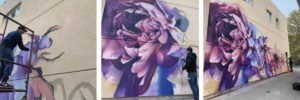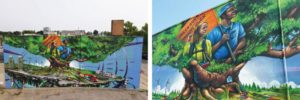These folks are not shy. They passionately believe in community-focused and community-driven artistic expression, and they do not dream small dreams.

In the downtowns of Durham, particularly in Oshawa, you may have come across a large outdoor mural painted onto the side of a building. This style of art is becoming more popular as local people have come to see and appreciate its value. Though some may view graffiti tags as a nuisance, there is a definite upswing in the number, size, beauty and transformational impact that these astounding pieces are having on our urban streetscapes.
A new and innovative initiative that recently started in the region, the Signs of Life Placemaking & Mural Project, works to place more of these artworks to beautify and benefit downtown Durham communities. Led by the team of Chad Tyson, muralist and owner/lead artist of The Paint Factory, and the award-winning event organizer, cultural planning and marketing strategist Rebekah Noseworthy, Signs of Life is brimming with forward-looking panache and ambition. According to their website, the project’s three main goals are: to seek to provide viable jobs that support Durham Region’s creative economy; provide thought-provoking work, spreading messages of hope, optimism, and addressing the hard truths our communities face; and impact a sense of pride, safety and security across Durham Region.
These folks are not shy. They passionately believe in community-focused and community-driven artistic expression, and they do not dream small dreams.

Photos courtesy of Signs of Life.
“If you see pictures of Oshawa’s downtown from 30 or 40 years ago, there are lineups around the corner for some of the stores—it was booming,” said Tyson. Over the subsequent decades, the downtown experienced an ebb and flow in business and population density, but with the expansion of Ontario Tech University and the ongoing development of other anchor businesses and institutions, it seemed that downtown Oshawa was back on the rise. “And then they had another big struggle: the downtown was getting back on its feet, and you add COVID.”
“Signs of Life started because watching [what was happening in] our downtowns, especially in Oshawa, felt super depressing,” said Noseworthy. “The concept of creating a space that is welcoming, that is for human beings to see it, enjoy and feel welcome to be in—that’s the deeper level of placemaking, which is what we’re attempting to do here.”
Placemaking is a theory that has recently and rapidly gained greater public awareness and acceptance. People are encouraged to collectively reimagine and reinvent public spaces, particularly those found in locations that many people share. It goes beyond simply being a theory of urban design, focusing local leaders and planners on the physical, cultural and social connections to a space that comes to define it in its current form and how it evolves into the future.
Noseworthy points to an example from Europe that illustrates how understanding real-world human usage patterns can guide our decision-making processes. “They were planning this big renovation on a building and it happened to snow. So, they planned the paths based on where people naturally made their paths in the snow.” Making changes at the human level can vastly improve the usability, aesthetic quality, desirability and comfort of a space—factors that help draw people to these spaces. Signs of Life has made it the main thrust of their mission to do this in Durham—to help communities recover from the pandemic, to enhance the appeal of our downtowns, and to show off the depth of artistic skill and talent the region has to offer.
Part of the effort by these two Oshawa natives is motivated by a desire to bolster the region’s reputation. “That’s the other side of what we’re trying to do with Signs of Life—we’re really trying to instill a sense of pride for living here and the knowledge that comes from knowing more about where you live.”
Their vision isn’t confined to the larger downtowns in the more heavily populated southwest portion of the region—doing work in the smaller centres is not out of the question. However, the artwork in smaller places must sensitively account for the tastes of the residents personality of each space. “You need to have an understanding of the lay of the land and what’s geographically around there,” opined Noseworthy. “You can’t just ‘build it, and they will come’. You have to give people a reason to want to go and see something, and experience it for themselves.”

Photos courtesy of Signs of Life.
The most important message that Signs of Life brings to the table is that a capable arts community, right here in the Durham Region, can take on these projects and execute them at a high level of artistic excellence. As Signs of Life grows, one of the main challenges it must overcome is the lingering tendency to look to Toronto for urban mural art when a group led by homegrown talent can capably take on such projects. Providing those opportunities through projects contracted with local businesses and governments is the lifeblood of the group.
“We want to make you step outside your house and think, ‘holy smokes!'” says Tyson. “The more murals we do and the more work we do with them [local groups], the more opportunity is going to open for many of our local artists.”
NOTE: At the time of publishing, Durham Region and the Province of Ontario are in Step 3 of the Roadmap to Reopen; the Province’s three-step plan to safely and gradually lift public health measures, based on ongoing progress of provincewide vaccination rates and improvements of key public health and health care indicators. Residents are encouraged to follow health guidance when safely exploring their local communities, wash hands frequently, wear a mask and physically distance from others.
